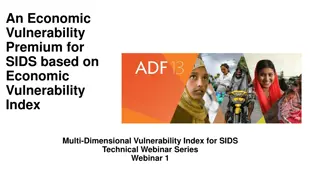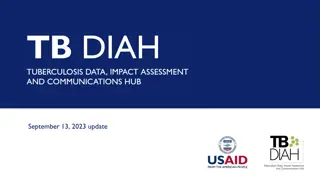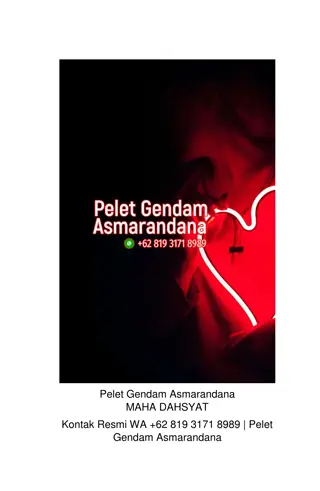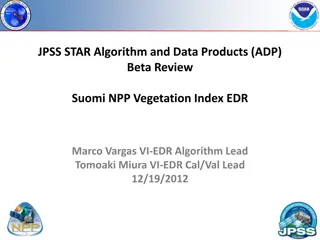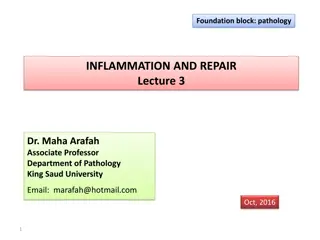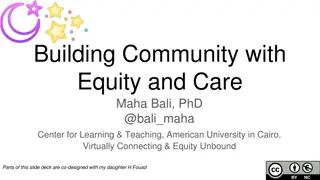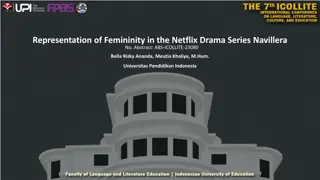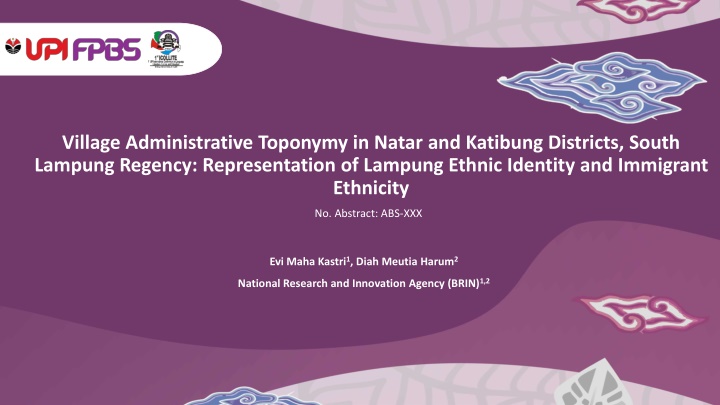
Representation of Lampung Ethnic Identity in South Lampung Regency
"Explore the village toponymy in Natar and Katibung Districts in South Lampung Regency, highlighting the significance of toponyms in reflecting Lampung ethnic identity and immigrant ethnicity. Learn about the cultural meanings and identity markers associated with village names in this diverse region."
Download Presentation

Please find below an Image/Link to download the presentation.
The content on the website is provided AS IS for your information and personal use only. It may not be sold, licensed, or shared on other websites without obtaining consent from the author. If you encounter any issues during the download, it is possible that the publisher has removed the file from their server.
You are allowed to download the files provided on this website for personal or commercial use, subject to the condition that they are used lawfully. All files are the property of their respective owners.
The content on the website is provided AS IS for your information and personal use only. It may not be sold, licensed, or shared on other websites without obtaining consent from the author.
E N D
Presentation Transcript
Village Administrative Toponymy in Natar and Katibung Districts, South Lampung Regency: Representation of Lampung Ethnic Identity and Immigrant Ethnicity No. Abstract: ABS-XXX Evi Maha Kastri1, Diah Meutia Harum2 National Research and Innovation Agency (BRIN)1,2
INTRODUCTION Toponymy has an important role as a marker or helper of a certain identity. To trace a source of a toponym, there are three ways, namely by looking for written, oral, and observational sources. The source of the writing is obtained from books and maps as well as related internet sources. Oral sources are obtained from individuals, while observations are made through visiting the target place of the toponym (Erikha, 2018: 18) Naming or toponymy always contains a story or story of its formation, therefore toponymy is often associated with the identity of a place so that toponymy is also closely related to meaning. A toponymy is likely to have a meaning behind its name. Toponymy also often has many cultural meanings that also store cultural values in it. People usually give names related to an event, story, and character. Many places store their own story backgrounds that can usually provide a learning to their people. This study aims to 1) identify village names and then categorize village names according to the naming aspect, (2) describe the associative meaning in village naming, and (3) describe the emotive meaning contained in village naming. South Lampung Regency is one of the areas targeted by the transmigration program, both general transmigration and self-directed transmigration, and the target of independent migration of residents from other provinces. This has an influence on the state of the toponyms of village names in each existing sub-district.
LITERATURE REVIEW Research that examines the naming of administrative areas such as village naming has existed before. Starting from research (Budiono et al., 2023), (Budiono & Firdaus, 2022), and (Pertiwi et al., 2020). In the study (Budiono et al., 2023), the toponyms of various regions in the city of Pekanbaru are described by classifying village names based on their basic toponymy, focusing on lexico- semantic aspects and sociolinguistic aspects, especially ethnicity, language use, and code mixing. The results of the study show that most of the local toponyms in the city of Pekanbaru refer to certain geographical conditions, trees, hopes, and rivers. In this study (Budiono & Firdaus, 2022), we document the naming patterns of administrative areas, explore identity markers in the naming of administrative areas, and protect linguistic and cultural peculiarities in the naming of administrative areas in Sanggau Regency. The research (Pertiwi et al., 2020) uses the focus of this research study in the form of toponymy categories of village names based on aspects of naming, cultural meaning, and cultural values contained in the toponymy of villages in Ponorogo Regency. What distinguishes this study from previous research is the uniqueness of village naming in Natar and Katibung Districts in South Lampung which has the characteristics of areas with heterogeneous populations, namely the indigenous people of Lampung and immigrant communities. The villages inhabited by immigrant communities come from transmigration and independent migration.
METHOD This research was conducted in a sociolinguistic and semantic framework to trace the naming of administrative areas in village names, explore identity markers in the naming of administrative areas, and protect the peculiarities of language and culture in the naming of administrative areas. The research uses a descriptive qualitative approach to analyze the data. The data source is the names of villages in Natar and Katibung Districts, South Lampung Regency, which were collected by taking photos of the village name boards. Data collection was carried out by rewriting the text written on the village office signboard and by recording a brief interview with the village officials/village community leaders. Six respondents were selected based on their regional language. The analysis is more about the interpretation of the respondents from their linguistic point of view.
FINDING AND DISCUSSION (Kumala & Lauder, 2021) said that the toponym or name of the region is not only a form of word but has significance in social life. Names must have meaning and are interpreted by the community. The meaning of a toponym reveals information social, cultural, historical, migration patterns, or identity politics. Furthermore, the meaning of tonyms is studied from the theory of presuppositional meaning of tonyms by Nystr m which is divided into categorical meaning, associative meaning, and emotive meaning. In this case, it is said that names as a form of vocabulary have a relationship with lexicons that are associated or targeted by the owner or shaper of the name because it is related to the association or emotive aspect that they have. Nystr m explained the meaning of associative as a form of expression that is personal, that is, it can be different from one person to another, or from one group to another. Meanwhile, emotive is a meaning that, when heard, evokes emotional turmoil over certain events, feelings, or memories.
FINDING AND DISCUSSION FINDING AND DISCUSSION Categorical meanings include: Expectations: Desa Bandarejo, Desa Bumi Sari, Desa Candimas, Desa Kalisari, Desa Krawang Sari, Desa Mandah, Desa Merakbatin, Desa Purwosari, Desa Rejosari, Desa Rulung Mulya, Desa Rulung Sari, Desa Sidosari, Desa Sukadamai, Desa Tanjung Sari, Desa Wai Sari, Desa Karya Tunggal, Desa Neglasari, Desa Pardasuka, Desa Sidomekar, Desa Sukajaya. Geomorphology: Desa Banjar Negeri, Desa Natar, Desa Rulung Helok Vegetation: Desa Tanjung Sari, Desa Tanjungan, Desa Babatan, Desa Tanjung Agung Fauna: Desa Merak Batin Social Events: Desa Beranti Raya, Desa Haduyang, Desa Hajimena, Desa Pancasila, Desa Pemanggilan, Desa Rangai Tri Tunggal, Desa Tarahan, Desa Trans Tanjungan Cultural Events: Desa Haduyang, Desa Hajimena, Desa Kalisari, Desa Krawang Sari, Mandah, Merakbatin, Desa Negara Ratu, Desa Pemanggilan, Desa Rejosari, Desa Tanjung Ratu Community Identity: Desa Pancasila Hydronym: Desa Kali Sari, Desa Krawang Sari, Desa Muara Putih
Distribusi Makna Toponim Desa-desa di Kecamatan Natar Asal Bahasa Nama Unsur Rupabumi Makna Titik Koordinat Kantor Desa 1. Desa Bandarejo bahasa Jawa Bandar kota dan rejo ramai/makmur . Jadi arti Bandarejo adalah kota yang ramai/makmur . 05 13'01.31" S 105 17'16.04" T 2. Desa Banjar Negeri bahasa Lampung Banjar berbaris/berbanjar negeri desa . Banjar Negeri adalah desa yang berbaris/berbanjar . 05 13'03.66" S 105 10'27.62" T 3. Desa Branti Raya bahasa Lampung dan bahasa Indonesia Berasal dari kata beratih tempat pemberhentian atau tempat peristirahatan . 05 14'19.78" S 105 10'15.62" T 4. Desa Bumi Sari bahasa Indonesia Berasal dari kata bumi hasil bumi yang berkelimpahan dan sari pokok (diambil dari kata Tanjung Sari karena desa ini merupakan pemekaran dari Desa Tanjung Sari). Jadi Bumi Sari berarti pokok hasil bumi yang berkelimpahan . 05 17'09.26" S 105 11'25.61" T 5. Desa Candi Mas bahasa Jawa + bahasa Indonesia Berasal dari kata candi sunyi sepi seperti makam dan mas emas . Jadi Candi Mas berarti wilayah yang sepi seperti makam diharapkan menjadi berharga seperti emas. 05 17'08.84" S 105 11'26.63" T 6. Desa Haduyang bahasa Lampung Haduyang berasal dari kata hadu selesai berdiri sebuah kampung dan kata yang tokoh adat/pendahulu yang memberi nama . Jadi Haduyang berarti sebuah kampung telah selesai didirikan oleh tokoh adat/ pendahulu . 05 13'23.20" S 105 10'18.79" T
Categories Language Usage The classification of language use in village toponyms in Natar District includes three languages, namely, Lampung, Javanese, and Indonesian. The variations in the use of language in village names in Natar and Katibung Districts are 1) using only 1 type of regional language (Lampung or Javanese), two types of languages, 2) using a combination of 2 types of regional languages (Lampung and Java), 3) using a mixture of Indonesian and regional languages. According to (Lauder & Lauder, 2015), the linkage between Indonesian and other language categories is important in relation to balancing development needs and equal distribution of opportunities as well as protection and respect for local values, knowledge, culture, and identity. Indonesia, with its great diversity of languages and cultures, is experiencing the loss of this diversity in the face of modernization, development, and globalization.
Meaning of Association Literally, Pancasila is the basis of the state and philosophy of the nation and state of the Republic of Indonesia which consists of five precepts. However, when the term Pancasila is used as the name of the village, an associative meaning appears, namely Pancasila Village has the meaning of five hamlets, based on Pancasila, and is free from PKI elements. Emotive Meaning The name Neglasari Village is taken from the name of the area where the residents come from. The village named Neglasari contains the meaning of negla which means "negrak" and "sari" which means to be neglasari which means a place that clearly looks beautiful. The name Pardasuka Village gives an emotive name that people are happy to live in this village. Parents in the past made oaths and promises that Pardasuka Village would one day progress and become a big city, the oath at that time was also made for Village Head officials who dared to corrupt, so their life would not be long (sourced from community stories)
CONCLUSION Based on the three stages of analysis above, the research data, namely village toponyms in Natar and Katibung Districts, have various meanings and also experience developments in their meaning. The existing toponyms illustrate that the analysis both lexical, semiotic, and toponymic meanings, the meanings that emerge cannot be separated from the social, cultural, and historical context related to the existence of each ethnic group that inhabits the village. The grouping of the meaning of the tonyms represents the existence of the tribe from which the villagers originate. The meaning of a toponym describes the name of a place in a cultural context can describe the existence or existence of an ethnicity. Through this research, it can be understood that the process of cultural preservation listed in government policies or related agencies should be carried out in a single cultural aspect. Policies on naming will unwittingly affect the collective memory and even the existence of an ethnicity.
REFERENCES Amran, F. (2016). Mencari Jejak Masa Lalu Lampung: Lampung Tumbai 2014 (U. Z. Karzi (ed.); 2nd ed.). Pustaka Labrak. Badan Pusat Statistik Kabupaten Lampung Selatan. (2022). Kecamatan Natar dalam Angka 2022 (Supardi (ed.)). BPS Kabupaten Lampung Selatan. https://lampungselatankab.bps.go.id/publication/2022/02/25/f632d36ce14cd17032812ae6/kabupaten-lampung-selatan-dalam- angka-2022.html Budiono, S., & Firdaus, W. (2022). Penanda Identitas Dalam Penamaan Wilayah Administrasi Di Kabupaten Sanggau. Linguistik Indonesia, 40(2), 227 243. https://doi.org/10.26499/li.v40i2.341 Budiono, S., Yance, I., & Wijayatiningsih, Y. F. (2023). Toponim Wilayah Kota Pekanbaru: Etnisitas, Bahasa, Dan Campur Kode. Paradigma: Jurnal Kajian Budaya, 13(2), 127 146. https://doi.org/10.17510/paradigma.v13i2.1151 Erikha, F. (2018). Modul: Toponimi. Direktorat Jenderal Kebudayaan Kementerian Pendidikan dan kebudayaan Republik Indonesia. Hadikusuma, H., Arifin, R., & Barusman, R. (1996). Adat Istiadat Daerah Lampung (W. Usman (ed.); 2nd ed.). CV Arian Raya. Hakim, L., Duli, A., Muhammad, H., Darheni, N., & Jogaswara, H. (2023). Bentuk dan Pola Kategori Toponim Desa dan Kelurahan di Kabupaten Lombok Tengah. September. Kridalaksana, H. (2008). Kamus Linguistik (4th ed.). PT Gramedia. Kumala, S. A., & Lauder, M. R. (2021). Makna Toponim di Tangerang sebagai Representasi Keberadaan Etnis Cina Benteng: Sebuah Kajian Linguistik Historis Komparatif. Ranah: Jurnal Kajian Bahasa, 10(2), 304. https://doi.org/10.26499/rnh.v10i2.4048 Lauder, A. F., & Lauder, M. R. M. T. (2015). Ubiquitous place names: Standardization and study in Indonesia. Wacana, 16(2), 383 410. https://doi.org/10.17510/wjhi.v16i2.383 Nystr m, S. (2016). Names and Meaning. In C. Hough (Ed.), The Oxford Handbook of Names and Naming (pp. 1 13). Oxford University Press. https://doi.org/10.1093/oxfordhb/9780199656431.013.26 Oktaviana, E. (2020). Toponimi Penamaan Desa di Kecamatan Kebomas Gresik Jawa Timur (Kajian Linguistik Antropologi). Jurnal Sapala, 7(1), 1 5. Peraturan Pemerintah. (2021). Governmental Regulation concerning to Administration of Geographical Names (Peraturan Pemerintah Nomor 2 Tahun 2021 tentang Penyelenggaraan Nama Rupabumi). 046839.
References References Pertiwi, P. P., Suyanto, S., & Astuti, S. P. (2020). Toponimi Nama-Nama Desa di Kabupaten Ponorogo (Kajian Antropolinguistik). Nusa: Jurnal Ilmu Bahasa Dan Sastra, 15(3), 330 340. https://doi.org/10.14710/nusa.15.3.330-340 Rahyono, F. X. (2015). Kearifan Budaya dalam Kata (2nd ed.). Wedatama Widya Sastra. Rais, J., Lauder, M., Sudjiman, P., Ayatrohaedi, Sulistiyo, B., Wiryaningsih, A., Suparwati, T., & Santoso, W. E. (2008). Toponimi Indonesia: Sejarah Budaya Bangsa yang Panjang dari Permukiman Manusia dan Tertib Administrasi (1st ed.). PT Pradnya Paramita. Shomami, A., & Lauder, M. R. M. . (2021). A Toponymic Study of The Meanings of Village Names in Cilacap, Central Java. In S. P. Suganda & A. Soriente (Eds.), Sociolinguistics and Dialectological Studies in Indonesia (pp. 237 254). Nova Science Publishers, Inc. Tamrin, T., & Haliq, A. (2023). Fenomena Geografis Makna Toponimi di Kota Makassar. Nuances of Indonesian Language, 4(2), 108 119. https://doi.org/10.51817/nila.v4i2.685 Transmigrasi, D. (1991). Transmigrasi di Lampung. Departemen Transmigrasi Provinsi Lampung. Utomo, K. (1975). Masyarakat Transmigran Spontan di Daerah Wai Sekampung (Lampung). Gadjahmada University Press. Wijaya, D. N., Wahyudi, D. Y., Umaroh, S. Z., Susanti, N., & Ertrisia, R. A. P. (2021). The toponymy of the villages in Ambon Island: A historical and archaeological study. Berkala Arkeologi, 41(1), 89 108. https://doi.org/10.30883/jba.v41i1.600 World, S. (n.d.). Key Challenges in Geography Place Naming , Identities and Geography Critical Perspectives in a Globalizing and.
THANK YOU! Follow us @...





